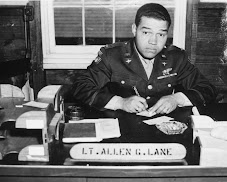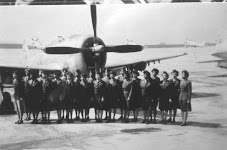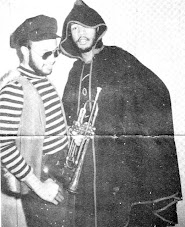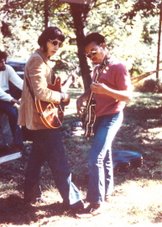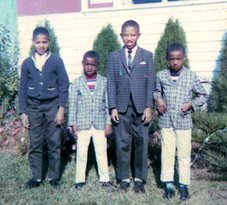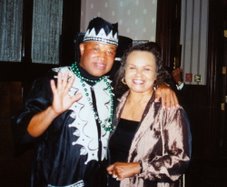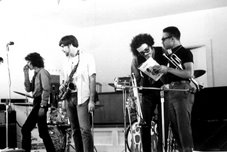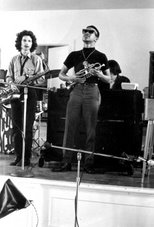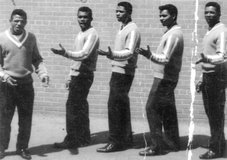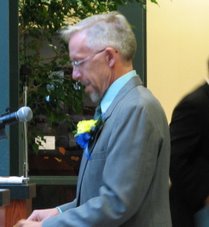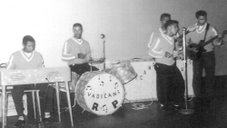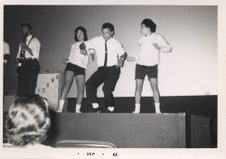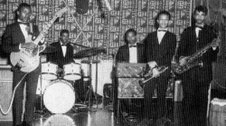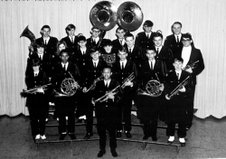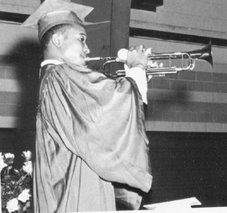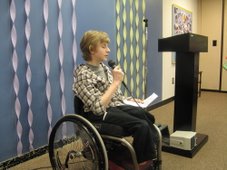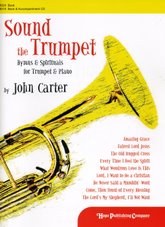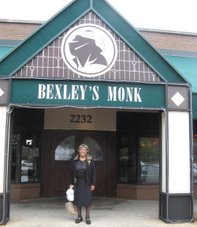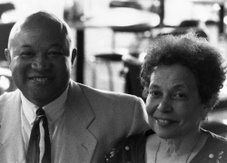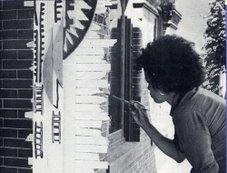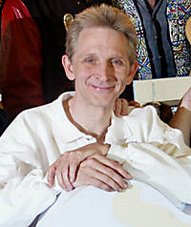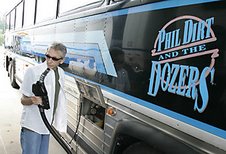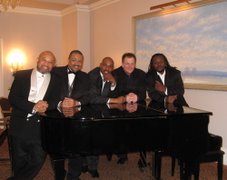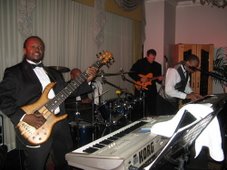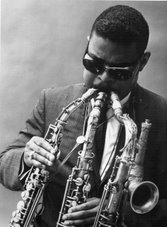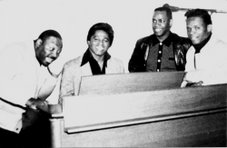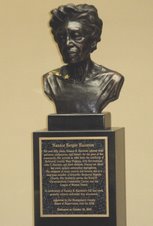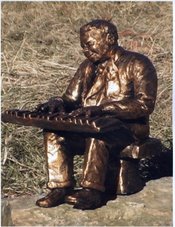
Arnett Howard Finds Gold In His Basement:
Pianist Stomp Gordon’s Scrapbook
Dec. 11,1997
The world has its stories of discovered treasures, the collector who finds a rare master painting beneath the ruins of another. Discoveries have been made in libraries of rare signed first editions that become worth millions overnight.
My discovery is not going to make for my retirement but will be exciting to a handful of friends in a close circle of Columbus jazz lovers. In my basement today, I discovered the scrapbook of a legendary pianist,
Archie “Stomp” Gordon. In the 1980’s, I have vague memories of a woman coming to my apartment in German Village, telling me that she had retrieved a very tattered scrapbook from the trash and asking me if I wanted it. I looked at a page or two of this very ragged book, closed it and told the person that I didn’t think the book had much value because of its condition, yellowed news print and torn, water stained pages. I think I gave her fifty dollars, not for the book but for cab fare home since the disabled woman with a small son didn’t drive.
The book was put into a box, onto a shelve, moved from an apartment to my new home, replaced on a shelf and forgotten. Today I started hunting for a piece of tee shirt art that I’ve also moved around for ten years. Hoping to create a 1998 sweat shirt design with the art, I decided to hunt for it in my storage.
I’m about to embark on a research project for the Ohio Historical Society to document the legacy of our state’s jazz entertainers. My eyes are open for many of the artifacts that I gathered in the early 1980’s as I archived Columbus’ Black entertainers and as I opened this box my soul was about to be filled.
When I interviewed “Old Boss”,
H. Raleigh Randolph, in 1980, he introduced me to some wonderful promo pictures of Archie “Stomp” Gordon, a pianist who grew up on Columbus’ South side. Old Boss was quite proud of his mentoring friendship with Stomp, a gifted teenager who was leading his band of neighborhood kids on professional bookings, not only in Columbus, but throughout Central Ohio.I remember stories my father shared with me of Stomp playing at my parent’s alma mater, Bluefield West Virginia State Teacher’s College in the late 1940’s.
One saga came from Hall of Fame saxophonist
Rusty “Night Train” Bryant, who at age eleven begged Stomp to let him join the band of jazzy rascals. Stomp told Rusty to get a saxophone, learn how to play and he’d let him into the band. Reports have it that Rusty got his sax from his father and proceeded to become one of America’s best known saxophonists due to his rocking hit,
All Night Long.
Rusty remembered a night when Stomp Gordon’s teenagers took the interurban train to London, Ohio, to play a dance. After the dance was over, the group went back to the train station, but the last train had departed; so they were forced to bed down on the platform to await the next morning’s train.
One Christmas holiday in the early 1980’s I met
Bruce Woode, bassist with Gordon. I remember riding about the streets of Columbus with him and friends as he was visiting from his home in New Jersey. He was a warm and friendly personality, eager to share with his curious young friend the days in the 1950’s when Stomp Gordon was riding the hit parade and playing the best showrooms trying to entertain and integrate America.
Bruce clearly recalled during our evening together a night when the band was tearing up a colored nightclub in New Jersey. The group was known for the wild high jinks in their act. Stomp would play a high piano standing up and the novelty of his name lie in his ability to kick off his shoes, socks and tickle the ivories with his toes. Bruce would lay his bass violin on the floor and play it. They wore animal skin dinner jackets in their wild show that
Jimmy Crum would envy.
Bruce remembered a conspicuous group of white teens who were out of place in this club but eating up every trick that Stomp’s band was using to entertain. Bruce told me that he was certain that this group of white teenagers became
Bill Haley and the Comets and they used all of the gimmicks that they saw that night as they became America’s icons of the new rock and roll movement.
Tony Vance was one of my neighbors in German Village (South Columbus, Ohio) and a saxophonist in Stomp’s early team of musical adolescents. Some of the Black jazz men referred to Tony’s nickname as “No Blow,” but whether he was a questionable talent or not he was on the scene with Gordon and shared slides with me of his photos of the early band. No one onstage looks over fifteen including the leader whose name was hand painted on the music stands.
So I was feeling groggy this morning when I came across the scrapbook which had not seen light since it came into my possession nearly ten years earlier. Stapled inside the cover was, no doubt, the enlargement that Stomp purchased when his high school senior pictures were developed. The sepia toned color print is of a brown eyed, handsome man in a gray suit with wide lapels, white shirt, patterned tie and white handkerchief in his breast pocket. The edges of the photo are wrecked, cracked from dryness and Stomp has a staple in his forehead. But the photo clearly shows that the young star was probably the best dressed senior that graduated from Columbus South High School that year, probably 1950.
The next stapled picture in the nearly ruined book composed of string and construction paper was of a smiling, mature white woman, who resembles baroness
Pannonica de Koenigswarter, a jazz patron, known for befriending
Charlie Parker and
Thelonius Monk. In truth is was the woman who became the mother of Gordon's children. She remains nameless.
The next artifact in the book is probably in the best condition. The center of the art board is hand lettered “
Stomp Gordon and His Orchestra,” and the sepia photos that surround the lettering are four action shots of the mini-orchestra. The saxophonist is the legendary
Hiawatha, Bruce Woode is holding his string bass at shoulder level,
Chick Glenn has his drumsticks high and Stomp has his hands held high in a mock attack of the piano.
The newspaper clippings contained here are long yellowed but very readable and the first is identified from the Philadelphia Daily News, February 26, 1953. It is a twenty photo feature, “Around The Clubs” promoting the week’s entertainers including stars
Danny Thomas at the Latin Casino, pioneer Negro actor
Mantan Moreland at the Town Tavern, jazz clarinetist
Buddy DeFranco at the Blue Note,
Buddy Greco at the Rendezvous and Stomp Gordon at the Butler Cafe.
The next clipping must have been Stomp’s favorite promo picture, he is perched on a very high stool, mouth open wide, hands high and bare feet flailing at the piano keys. The caption reads,
“Look at him, old Toe Stomping Gordon wailing away up at Butler’s cafe. This mad man, who plays piano with his toes, is making his first East coast appearance... is in such great demand that he is here for only one week.”Another black and white photo is in superb condition of the five performers boarding a Delta airliner and posed with huge smiles. The photo is embossed “Pierce’s Studio, Columbus, Ohio,” so the boarding is likely at Port Columbus.
The next item is pasted to construction paper and there is likely information hiding on the other side. The
Joe Glaser Agency promotion flyer says
“Now Available...King of Bop and Boogie. The character who stomped his way to fame with his All Star Combo. Hottest Music In Town.. in person Stomp Gordon, one ton of torrid rhythm.” A head shot of the leader is pasted on a cartoon of white hands playing an upright piano. Glaser was also agent-manager who directed
Louis Armstrong’s career.
The next very yellowed articles document an appearance at 1042 Club by nationally loved jazz singer
Billie Holiday, “America’s No. 1 Song Stylist”. Billie had lost her New York cabaret performing license due to felony drug charges and the 1042 Club was located as far from the Big Apple as possible; Anchorage, Alaska.
“The other group is the Stomp Gordon Combo. Gordon, it will be recalled, he is the pianist who plays with his feet.” Admission was $2.50, with a $7.50 minimum, includes setup and 1/2 pint of your favorite whiskey or drink.
The fore mention promo picture of Toe Stomping Gordon is pasted on the next leaf with two of his sidemen clear, Hiawatha and Bruce. At the bottom the glossy reads “Decca recording Artist, Associated Booking Corp., New York, Chicago, Hollywood.”
The Gordon Orchestra traveled the roads of America in a 1955 Plymouth station wagon, Ohio license number E 12391 and Stomp seemed to pride himself in a growing collection of traffic violations. Municipal notices that appeared in his archives were from Wildwood, New Jersey (driveway); Philadelphia; Niagara Falls, New York (in alley); Montreal; Atlantic City; Atlanta (wrong way one way street); Goshen, New Jersey (speeding); (Green Bay (overtime parking); St./ Louis (parked contrary to legal signs); and Columbus.
He addressed a February 22, 1953, letter to the
Early Family in Columbus,
“Hello Drake, Marvin, Nickademus, Bob, Louis and Leola. Hi sweet heart! Here is a ticket to add to my scrap book. Please Please save everything I send you.
I am going to start putting you on my payroll. I am going to send you $10.00 each 9th day of the month to cover all of my postage that you send to me, OK? I will write more next time. Please hold all mail until I send for it. Stomp Gordon.”The next page has clippings from the Washington Daily News, February 19, 1953, entitled “Tips On Tables” under a byline by
Ray Keziah. “On first glance he looks like the Wildman From Borneo. I had just sat down to catch the Blue Mirror’s Seven Star Holiday Revue...and it happened Stomp Gordon and his Combo made their entrance. Dig this... Stomp’s musical attire consists of zoot pants, a zebra length drape coat with waist-length flowing yellow handkerchief and a head of hair that would make Charles Antell cry.
And Stomp’s music is just as wild as his outfit. On one jam session they paraded ‘round the room on the tables, under the tables and almost climbed up the wall.” Dated September 11, 1954, is the Alaska Spotlight from Anchorage and it documents Stomp’s complaint of racial discrimination. According to Stomp, who is alleging to be “a graduate and former football great of the Ohio State University, ... upon arriving at the Last Chance his party was told by the girl at the door ‘colored people aren’t admitted.’ However, the manager, upon hearing the statement rushed forward and exclaimed, ‘ Oh no, that’s not the reason; you have no reservations.’
The article cited race riots occurring with ‘Negro servicemen who had been refused admission and it alluded to the possibility that Gordon might file charges against the club in violation of the Alaska Civil Rights Act.
Also on the page was a totally blank check No. 0025 from the High-Town Office of The Ohio National Bank of Columbus on the account of Stomp Gordon and His Orchestra, 745 Fifth Avenue, New York, 22, N.Y., Phone Plaza 9-4600. Another check is written to
Jerome Early for No dollars and twenty-five cents. Stomp Gordon, 241 Barthman Avenue on Columbus’ South end. There was once a record shop serving Downtown Columbus called Early’s Record’s, located on West Town Street, near Lazarus Department Store and I wonder if it’s the same Early.
There is another
George Pierce Photo in the book. The featured four musicians include
Boyd Moore on bass,
Charlie Johnson (Springfield) on drums, an unidentified pianist and
Eva Gee, vocalist.
The next page has a mixture of clippings, photos and fibs to commemorate the end of his run at the 1042 Club in Anchorage on New Year’s Eve, 1954. “His next booking is at the Latin Quarter in Paris, France, January 4th.” I wonder if he took the Plymouth across the Atlantic. October 9, 1954, Stomp received correspondence in Alaska from
Cleveland d’Entremant pushing a French song entitled “Que Diriez Vous (What Would You Say?),” probably in anticipation of his auto trip to Paris
Another snapshot features Stomp and Hiawatha in Atlantic City in a novelty photo, another has Stomp behind a piano in August, 1955. Two envelopes are postmarked Philadelphia and Louisville when Liberty postage was three cents. The addressees are Mrs. Ida Early and Shirley Early, Stomp’s girlfriend, both 742 E. Spring Street, Columbus, 3, Ohio and the envelopes bear two different printings from “The Stomp Gordon Fan Club.”
The business sized envelope features a notice printed in red ink, “Mr. Postman, Please guard this real gone letter with your life. Dig man!!! If necessary call out the police, the National Guards, or the F.B.I. But by all means protect this letter with your life otherwise 100,000,000,000,000 Teens and Twenties will have your head. Daddy-O. The reason????? This letter contains that New dance Sensation of the year called The Grind.” I met Stomp’s daughter,
Sheila Kidd, in the early 1980’s and she let me record some very scratchy 45 rpm records and one title was “The Grind.”
The next page features family pictures of Stomp. In two of the snaps dated November, 1955, he is with a pretty young woman identified by pianist
Bobby Shaw as Shirley. Stomp holds the tiny infant with the look of a new father. The picture that is captioned “Maestro Gordon” appears as if it had been taken in the early 1940’s with a vintage delivery truck in the background behind a fourteen year old Stomp.
The scrapbook holds promo glossy of the band trumpeter
Billy Brooks and school photos from two young women appear next. Both are bright, smiling, very fair complexion, but neither resemble Stomp who had a medium to dark brown hue to his skin. Bobby Shaw says that the youngest girl is Stomp’s daughter,
Felicia, who was killed in an auto accident.
The next promo photo of Boyd Moore and his Orchestra identifies two former faces, singer Eva Gee and drummer
Eddie Littlejohn. A browning and tattered print is a club shot of the Stomp Gordon Band with clear looks at Bruce Woode, bass, Stomp nearly obscured by the piano and Hiawatha behind his tenor sax, but the drummer is a face that I’ve never seen .
Headlines on a newspaper clipping read “Gleason getting Surprise Package In Stomp Gordon.” Gleason’s Musical Bar was likely on Woodland Avenue in Detroit, since one of the acts appearing on the show was
Choker Campbell’s Orchestra, which became the tour orchestra behind the Motortown Review in the mid 1960’s. “Gordon plays good music, but his real strength lies in his clowning and showmanship. He takes off his shoes and socks and knocks out the blues with his toes...people go for it.” A snapshot from the nightclub has five men seated and four that I can identify are Sylvester Birch, blues legend
Charles Brown, Stomp and youthful saxophonist
Carl Sally on his left..
According to the next receipt, dated October 28, 1950, Stomp paid a stiff $80.00 fine to the Portsmouth, Ohio, Local of the American Federation of Musicians. A newspaper chart of best selling records had his recordings
Oooh Yes and
Please Don’t Pass Me By, in the top five of Rhythm and Blues charts behind
Louis Jordan and a sensational
Sister Rosetta Tharp who had three of the five songs.
The results of a 1950’s Downbeat national jazz poll was the subject of a large clipping and Stomp received a number of votes behind
Dave Brubeck as instrumental combo and
Oscar Peterson as pianist. I recognized a page from the Chicago based Jet, a Negro weekly magazine, as it cited “Feet Piano Players,” Stomp and
Bernice Rouse Knighten.
Another advertisement features the Gleason’s lineup of Gordon, Choker Campbell and Good Time Charles Brown, blues legend. A loose item in the scrapbook is a retirement congratulations, dated July 18, 1978. The letter, on Ohio Department of Transportation letterhead, thanks Jerome S. Early for his efforts of twenty five years.
One of the last items is a very ominous looking photo of a bare chested man lying in bed next to a telephone. If this is Stomp, he doesn’t look well. The hand drawn musical manuscript that is the last artifact in the volume is entitled
Good Night Little Girl.
“Good night, little girl. I hope you make it home all right. With each glass of wine your kisses are more fine...” I carefully close the ragged scrapbook to seek my own
Musician’s Scrapbook. I was looking for a clipping from the Ohio State Journal dated Tuesday, January 21, 1958 that closes the book on Stomp Gordon.
“Archie A. “Stomp” Gordon, a 26 year-old Columbus musician, was found dead in a parked car on New York's City’s Madison Avenue late Sunday night. The body was not identified until early Monday morning.” Police found the piano player slumped over the wheel of his station wagon... the body was taken to Bellevue Morgue where it was identified by one of the members of the five-piece orchestra he had taken to New York. New York medical examiners said an autopsy disclosed Gordon died of pneumonia and a liver ailment.” It is unknown when or how but it has been said Stomp picked up a heroin habit. “Horse” was the rage of jazzy players during the 1940’s and 50’s when
Charlie Parker was influencing the scene with his revolutionary sax playing and other bad habits. It is said that Stomp at the time of his death was carrying the legacy of being the
Fats Waller of his generation, making his music wild fun and pushing entertainment far past its boundaries.
Well, I’ve discovered Stomp again and since he left his scrapbook and traffic tickets to me for safe keeping, I’d like bring him back onstage once again for people to enjoy.
“Whomp, bebop, boom, bam. I’m a killer diller, yes I am!”









